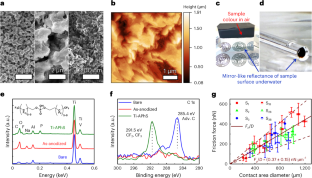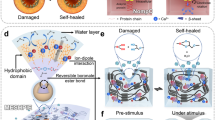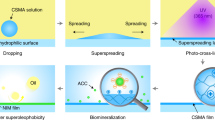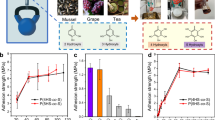Abstract
Aerophilic surfaces immersed underwater trap films of air known as plastrons. Plastrons have typically been considered impractical for underwater engineering applications due to their metastable performance. Here, we describe aerophilic titanium alloy (Ti) surfaces with extended plastron lifetimes that are conserved for months underwater. Long-term stability is achieved by the formation of highly rough hierarchically structured surfaces via electrochemical anodization combined with a low-surface-energy coating produced by a fluorinated surfactant. Aerophilic Ti surfaces drastically reduce blood adhesion and, when submerged in water, prevent adhesion of bacteria and marine organisms such as barnacles and mussels. Overall, we demonstrate a general strategy to achieve the long-term stability of plastrons on aerophilic surfaces for previously unattainable underwater applications.
This is a preview of subscription content, access via your institution
Access options
Access Nature and 54 other Nature Portfolio journals
Get Nature+, our best-value online-access subscription
$29.99 / 30 days
cancel any time
Subscribe to this journal
Receive 12 print issues and online access
$259.00 per year
only $21.58 per issue
Buy this article
- Purchase on Springer Link
- Instant access to full article PDF
Prices may be subject to local taxes which are calculated during checkout





Similar content being viewed by others
Data availability
All data are available in the main text or Supplementary Information. All relevant data are available from the corresponding authors upon reasonable request.
References
Quéré, D. Wetting and roughness. Annu. Rev. Mater. Res. 38, 71–99 (2008).
Field, R. in Membrane Technology (eds Peinemann, K.-V. & Nunes, S. P.) 1–23 (Wiley-VCH, 2010).
Cámara, M. et al. Economic significance of biofilms: a multidisciplinary and cross-sectoral challenge. npj Biofilms Microbiomes 8, 42 (2022).
Davis, J. R. in Corrosion: Understanding the Basics (ed. Davis, J. R.) Ch. 1, 1–17 (ASM International, 2000).
Marmur, A. in Non-wettable Surfaces: Theory, Preparation and Applications (eds Ras, R. H. A. & Marmur, A.) 1–11 (The Royal Society of Chemistry, 2017).
Rapoport, L., Emmerich, T. & Varanasi, K. K. Capturing bubbles and preventing foam using aerophilic surfaces. Adv. Mater. Interfaces 7, 1901599 (2020).
Cassie, A. B. D. & Baxter, S. Wettability of porous surfaces. Trans. Faraday Soc. 40, 546–551 (1944).
Lu, Y. et al. Robust self-cleaning surfaces that function when exposed to either air or oil. Science 347, 1132–1135 (2015).
Wang, D. et al. Design of robust superhydrophobic surfaces. Nature 582, 55–59 (2020).
Peng, C., Chen, Z. & Tiwari, M. K. All-organic superhydrophobic coatings with mechanochemical robustness and liquid impalement resistance. Nat. Mater. 17, 355–360 (2018).
Tesler, A. B. et al. Extremely durable biofouling-resistant metallic surfaces based on electrodeposited nanoporous tungstite films on steel. Nat. Commun. 6, 8649 (2015).
Poetes, R., Holtzmann, K., Franze, K. & Steiner, U. Metastable underwater superhydrophobicity. Phys. Rev. Lett. 105, 166104 (2010).
Chen, F. et al. Robust and durable liquid-repellent surfaces. Chem. Soc. Rev. 51, 8476–8583 (2022).
Hwang, G. B. et al. The anti-biofouling properties of superhydrophobic surfaces are short-lived. ACS Nano 12, 6050–6058 (2018).
Mehanna, Y. A. et al. The challenges, achievements and applications of submersible superhydrophobic materials. Chem. Soc. Rev. 50, 6569–6612 (2021).
Seymour, R. S. & Matthews, P. G. D. Physical gills in diving insects and spiders: theory and experiment. J. Exp. Biol. 216, 164–170 (2013).
Srinivasan, S. et al. Quantification of feather structure, wettability and resistance to liquid penetration. J. R. Soc. Interface 11, 20140287 (2014).
Yu, C., Zhang, P., Wang, J. & Jiang, L. Superwettability of gas bubbles and its application: from bioinspiration to advanced materials. Adv. Mater. 29, 1703053 (2017).
Flynn, M. R. & Bush, J. W. M. Underwater breathing: the mechanics of plastron respiration. J. Fluid Mech. 608, 275–296 (2008).
Marmur, A. Underwater superhydrophobicity: theoretical feasibility. Langmuir 22, 1400–1402 (2006).
Lafuma, A. & Quéré, D. Superhydrophobic states. Nat. Mater. 2, 457–460 (2003).
Marmur, A. & Kojevnikova, S. Super-hydrophobic surfaces: methodological considerations for physical design. J. Colloid Interface Sci. 568, 148–154 (2020).
Beranek, R., Hildebrand, H. & Schmuki, P. Self-organized porous titanium oxide prepared in H2SO4/HF electrolytes. Electrochem. Solid State Lett. 6, B12 (2003).
Cousins, I. T., Johansson, J. H., Salter, M. E., Sha, B. & Scheringer, M. Outside the safe operating space of a new planetary boundary for per- and polyfluoroalkyl substances (PFAS). Environ. Sci. Technol. 56, 11172–11179 (2022).
Filippin, N. et al. Plasma-enabled amorphous TiO2 nanotubes as hydrophobic support for molecular sensing by SERS. ACS Appl. Mater. Interfaces 12, 50721–50733 (2020).
Liu, K., Vuckovac, M., Latikka, M., Huhtamäki, T. & Ras, R. H. A. Improving surface-wetting characterization. Science 363, 1147–1148 (2019).
Backholm, M. et al. Water droplet friction and rolling dynamics on superhydrophobic surfaces. Commun. Mater. 1, 64 (2020).
Timonen, J. V. I., Latikka, M., Ikkala, O. & Ras, R. H. A. Free-decay and resonant methods for investigating the fundamental limit of superhydrophobicity. Nat. Commun. 4, 2398 (2013).
Marmur, A., Della Volpe, C., Siboni, S., Amirfazli, A. & Drelich, J. W. Contact angles and wettability: towards common and accurate terminology. Surf. Innov. 5, 3–8 (2017).
Thamaraiselvan, C., Manderfeld, E., Kleinberg, M. N., Rosenhahn, A. & Arnusch, C. J. Superhydrophobic candle soot as a low fouling stable coating on water treatment membrane feed spacers. ACS Appl. Bio Mater. 4, 4191–4200 (2021).
Xu, M., Sun, G. & Kim, C.-J. Infinite lifetime of underwater superhydrophobic states. Phys. Rev. Lett. 113, 136103 (2014).
Deng, X., Mammen, L., Butt, H.-J. & Vollmer, D. Candle soot as a template for a transparent robust superamphiphobic coating. Science 335, 67–70 (2012).
Jokinen, V., Kankuri, E., Hoshian, S., Franssila, S. & Ras, R. H. A. Superhydrophobic blood-repellent surfaces. Adv. Mater. 30, 1705104 (2018).
Froes, F. H. in Titanium in Medical and Dental Applications (eds Froes, F. H. & Qian, M.) 3–21 (Woodhead Publishing, 2018).
Chae, K. et al. Antibacterial infection and immune-evasive coating for orthopedic implants. Sci. Adv. 6, eabb0025 (2020).
Hall-Stoodley, L., Costerton, J. W. & Stoodley, P. Bacterial biofilms: from the natural environment to infectious diseases. Nat. Rev. Microbiol. 2, 95–108 (2004).
Friedlander, R. S. et al. Bacterial flagella explore microscale hummocks and hollows to increase adhesion. Proc. Natl Acad. Sci. USA 110, 5624–5629 (2013).
Lee, H., Scherer, N. F. & Messersmith, P. B. Single-molecule mechanics of mussel adhesion. Proc. Natl Acad. Sci. USA 103, 12999–13003 (2006).
Kamino, K. Mini-review: barnacle adhesives and adhesion. Biofouling 29, 735–749 (2013).
Backholm, M. & Bäumchen, O. Micropipette force sensors for in vivo force measurements on single cells and multicellular microorganisms. Nat. Protoc. 14, 594–615 (2019).
Junaid, M., Nurmi, H. A., Latikka, M., Vuckovac, M. & Ras, R. H. A. Oscillating droplet tribometer for sensitive and reliable wetting characterization of superhydrophobic surfaces. Droplet 1, 38–47 (2022).
Akbari, R. & Antonini, C. Contact angle measurements: from existing methods to an open-source tool. Adv. Colloid Interface Sci. 294, 102470 (2021).
Huhtamäki, T., Tian, X., Korhonen, J. T. & Ras, R. H. A. Surface-wetting characterization using contact-angle measurements. Nat. Protoc. 13, 1521–1538 (2018).
Orella, M. J., Leonard, M. E., Román-Leshkov, Y. & Brushett, F. R. High-throughput analysis of contact angle goniometry data using DropPy. SoftwareX 14, 100665 (2021).
Myers, J. A., Curtis, B. S. & Curtis, W. R. Improving accuracy of cell and chromophore concentration measurements using optical density. BMC Biophys. 6, 4 (2013).
Rausch, M. et al. Measurement of skeletal muscle fiber contractility with high-speed traction microscopy. Biophys. J. 118, 657–666 (2020).
Jui-Cheng, Y., Fu-Juay, C. & Shyang, C. A new criterion for automatic multilevel thresholding. IEEE Trans. Image Process. 4, 370–378 (1995).
Benda, J. et al. Studying the effect of pre-polymer composition and incorporation of surface-modifying amphiphilic additives on the fouling-release performance of amphiphilic siloxane-polyurethane coatings. ACS Appl. Mater. Interfaces 14, 37229–37247 (2022).
Acknowledgements
We thank A. Marmur for fruitful discussions on the plastron stability of Ti-APhS. A.B.T. thanks N. Vogel and J. Harrer for help with AFM measurements and E. Alkhateeb for help with X-ray diffraction measurements. A.B.T. thanks F. Krause from Keyence Deutschland GmbH for providing a laser confocal microscope for surface roughness measurements. W.H.G. and A.B.T. are indebted to L. Nicholson (Master of Arts) for proofreading the manuscript. We acknowledge the provision of facilities and technical support by Aalto University at OtaNano’s Nanomicroscopy Center (Aalto-NMC). A.B.T., P.S., W.H.G. and B.F. thank the Deutsche Forschungsgemeinschaft (DFG; SCHM 1597/38-1 and FA 336/13-1) for their financial support. A.B.T. acknowledges the Emerging Talents Initiative (ETI) of the Friedrich-Alexander-Universität Erlangen-Nürnberg (grant agreement number 5500102). This work was funded in part by grants from the German Science Foundation (DFG; FA 336-12/1, TRR-SFB 225 Projects A01 and C02). J.V.I.T. acknowledges funding from the Academy of Finland Center of Excellence Program (2022–2029) in Life-Inspired Hybrid Materials (LIBER), project number 346112. M. Backholm acknowledges postdoctoral funding from the Academy of Finland (grant agreement number 309237). M. Bruns, B.K., H.A.N., M.L., Z.M.C., J.V.I.T. and R.H.A.R. acknowledge funding from the Academy of Finland Center of Excellence Program (2022–2029) in Life-Inspired Hybrid Materials (LIBER, project number 346109). S.S. acknowledges funding from the Office of Naval Research, US Department of Defense (grant N00014-17-1-2153). S.K. and J.A. acknowledge funding from the Office of Naval Research, US Department of Defense (grants N00014-15-1-2323 and N00014-17-1-2913) and the Department of Energy (award DE-SC0005247).
Author information
Authors and Affiliations
Contributions
A.B.T. conceived the original idea for the project. A.B.T. developed the anodization method to form highly rough aerophilic Ti substrates with hierarchical structures and analysed the formation mechanisms. A.B.T. and S.K. screened and down-selected different coating compositions and fabrication methods, discovering the most promising designs for further study. A.M. performed XPS characterizations. A.B.T., L.H.P. and M. Bruns performed the plastron longevity characterization. A.B.T., L.H.P., M. Backholm, B.K., H.A.N. and M.L. performed the wetting characterization and analysed the experimental data. A.B.T., I.T., L.F., D.B., B.F. and W.H.G. performed the anti-blood adhesion and anti-bacterial characterizations. A.B.T., Z.M.C. and J.V.I.T. performed the SEM, TEM and confocal microscopy characterizations. U.L. carried out the optical profilometry characterization. S.K. and S.S. performed the marine anti-biofouling characterization. A.B.T., S.K., B.F., S.V. and W.H.G. wrote the manuscript. A.B.T., S.K., R.H.A.R., B.F., P.S., S.V., J.A. and W.H.G. discussed the results and revised the manuscript. All authors contributed to the manuscript.
Corresponding authors
Ethics declarations
Competing interests
The authors declare no competing interests.
Peer review
Peer review information
Nature Materials thanks Björn Wickman and the other, anonymous, reviewer(s) for their contribution to the peer review of this work.
Additional information
Publisher’s note Springer Nature remains neutral with regard to jurisdictional claims in published maps and institutional affiliations.
Supplementary information
Supplementary Information
Supplementary Figs. 1–16, Tables 1 and 2 and Materials and Methods.
Supplementary Video 1
Spreading of water drops on the as-anodized (super-hydrophilic) Ti surface.
Supplementary Video 2
Adhesion of water droplets to Ti-APhS. The substrate tilt angle is ~0 degrees.
Supplementary Video 3
Measurements of the adhesive force on Ti-APhS using MFS.
Supplementary Video 4
Dynamic characteristics of air bubbles on Ti-APhS after 78 days of continuous immersion underwater.
Supplementary Video 5
Wetting properties of Ti-APhS before and after 14 and 67 days underwater at 0.5 m depth. The substrate tilt angle is 10 degrees.
Supplementary Video 6
Hot-water and cold-water jet impinging Ti-APhS. Jet pressure, 70 psi. An equivalent impinging mass is 900 grams.
Supplementary Video 7
Plastron stability under bending and twisting of Ti-APhS underwater.
Supplementary Video 8
WCA hysteresis before and after sand abrasion by 0.8 mm yttria-stabilized zirconia beads.
Supplementary Video 9
Affinity and CA hysteresis of blood to Ti-APhS.
Supplementary Video 10
Blood droplet on Ti-APhS removed by paper wipe.
Supplementary Video 11
Blood affinity to bare Ti immersed for 1 s, and Ti-APhS immersed 99 times at 1 s each.
Supplementary Video 12
Bare Ti and Ti-APhS in 1.5 M NaOH aqueous electrolyte under an applied potential of 10 V.
Supplementary Video 13
Blood droplets roll off bare Ti and off Ti-APhS immersed 99 times in the container with blood.
Supplementary Video 14
Water affinity, WCA hysteresis and blood affinity to aluminium SHS.
Supplementary Video 15
Sliding time window analysis of the bare Ti sample, super-hydrophilic Ti sample and Ti-APhS exposed to E. coli.
Rights and permissions
Springer Nature or its licensor (e.g. a society or other partner) holds exclusive rights to this article under a publishing agreement with the author(s) or other rightsholder(s); author self-archiving of the accepted manuscript version of this article is solely governed by the terms of such publishing agreement and applicable law.
About this article
Cite this article
Tesler, A.B., Kolle, S., Prado, L.H. et al. Long-term stability of aerophilic metallic surfaces underwater. Nat. Mater. 22, 1548–1555 (2023). https://doi.org/10.1038/s41563-023-01670-6
Received:
Accepted:
Published:
Issue Date:
DOI: https://doi.org/10.1038/s41563-023-01670-6



